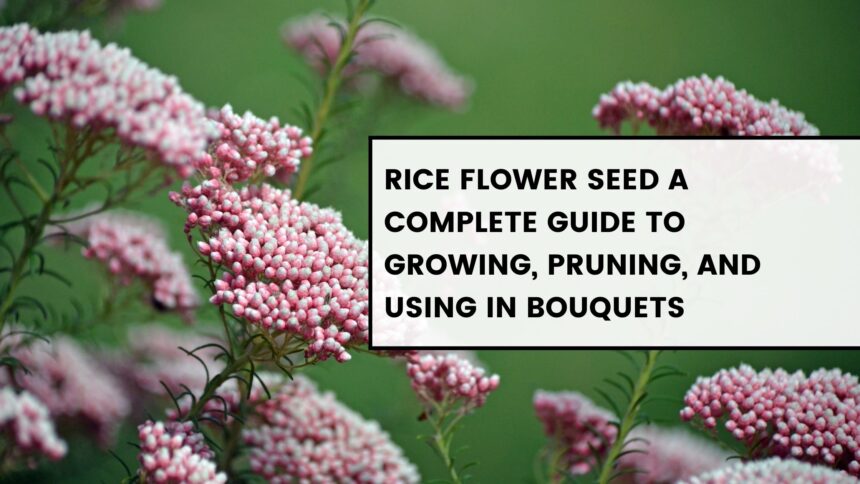Rice flower seeds (Ozothamnus diosmifolius), often called “rice bush” or “white dogwood,” produce beautiful, delicate blooms that are a favorite for bouquets and floral arrangements. This easy-to-grow plant adds a splash of white, pink, or cream to your garden, blooming for months and offering a long-lasting, drought-tolerant display. In this comprehensive guide, we’ll explore the best practices for growing rice flower from seed, pruning techniques, using the blooms in arrangements, and more.
What Are Rice Flowers?
Common Name: Rice Flower
Botanical Name: Ozothamnus diosmifolius
Color Variations: White, Pink, Cream
Blooming Season: Spring through Autumn
Height: Up to 1.5 meters
USDA Hardiness Zones: 9-11
The rice flower, native to Australia, is loved for its tiny, clustered flowers and soft foliage. These blooms are not only visually appealing but also drought-resistant and low-maintenance, making them a popular choice for gardeners and florists alike.
How to Grow Rice Flower from Seeds
Growing rice flowers from seeds is fairly simple. Here’s a step-by-step guide to ensure healthy growth:
Step 1: Prepare the Seeds
Rice flower seeds are small and should be planted in well-draining soil. It’s important to start them indoors if you live in a cooler climate. Sow the seeds about 1/4 inch deep and water gently.
Step 2: Germination
The seeds will typically germinate in 2-3 weeks. Keep the soil moist but not waterlogged. Place the seed tray in a sunny location or under a grow light.
Step 3: Transplanting
Once the seedlings have grown strong roots and are about 3-4 inches tall, they can be transplanted into your garden. Choose a sunny spot with well-draining soil, and space the plants about 12-18 inches apart.
Step 4: Watering
Rice flowers are drought-tolerant, but they still need regular watering, especially during the early stages of growth. Once established, they only need occasional watering.
Pruning Rice Flowers
Pruning is essential to encourage healthy growth and more abundant blooms. Here are some pruning tips:
- When to Prune: Prune after the first bloom in spring and again after the second bloom in autumn.
- How to Prune: Trim back about one-third of the plant, focusing on any dead or damaged branches. Use sharp pruning shears to make clean cuts.
Pruning not only keeps the plant healthy but also promotes fuller, more vibrant blooms.
Using Rice Flowers in Bouquets
Rice flowers are a florist’s favorite because of their long-lasting blooms and ability to dry beautifully. Here’s how to use them in floral arrangements:
- Fresh Bouquets: Rice flowers add texture and fullness to any bouquet. Their neutral colors make them versatile, pairing well with brighter blooms like roses or lilies.
- Dried Arrangements: Rice flowers dry easily. Simply hang them upside down in a cool, dry place for a week or two. Dried rice flowers maintain their shape and color, making them ideal for long-lasting arrangements.
Rice Flower Care Tips
- Sunlight: Full sun is ideal for rice flowers. They thrive in hot, dry climates.
- Soil: Ensure the soil is well-draining. Rice flowers do not tolerate waterlogged conditions.
- Watering: Once established, water sparingly. Overwatering can lead to root rot.
- Fertilizer: Use a balanced fertilizer during the growing season to encourage healthy blooms.
Can rice flowers grow indoors?
Yes, rice flowers (Ozothamnus diosmifolius) can be grown indoors, but they require some specific conditions to thrive. While they are typically outdoor plants due to their preference for full sunlight, you can successfully grow them indoors if you replicate their natural environment. Here’s how you can grow rice flowers indoors:
Growing Rice Flowers Indoors
1. Light Requirements
Rice flowers need plenty of sunlight. Indoors, place them near a south-facing window where they can get at least 6 hours of direct sunlight daily. If sufficient natural light isn’t available, consider using a grow light to ensure they get the brightness they need for healthy growth.
2. Container and Soil
Use a well-draining pot with holes to prevent water from accumulating at the roots. The ideal soil mix is a sandy or loamy potting soil that mimics the well-drained conditions rice flowers thrive in outdoors. Ensure the container is large enough to support the plant’s root system as it grows.
3. Watering
Indoor rice flowers should be watered sparingly. Allow the soil to dry out between waterings to avoid root rot. Overwatering is a common issue when growing rice flowers indoors, so check the moisture levels before adding more water.
4. Temperature and Humidity
Rice flowers prefer warm, dry conditions. Keep the indoor temperature between 60-75°F (15-24°C), and avoid placing the plant in areas with excessive humidity or drafts. They do not tolerate frost or cold temperatures, so make sure the indoor environment remains warm.
5. Pruning and Maintenance
Regular pruning is essential to maintain a compact shape and encourage flowering. Trim back dead or leggy growth and remove faded flowers to stimulate more blooms. This will also help manage the size of the plant indoors.
FAQs About Rice Flowers
How long do rice flowers bloom?
Rice flowers bloom from spring through autumn, offering months of color in your garden.
Can rice flowers survive frost?
Rice flowers are not frost-tolerant and should be grown in USDA zones 9-11 or in containers that can be moved indoors during colder months.
Do rice flowers attract bees or butterflies?
Yes, rice flowers are great for attracting pollinators like bees and butterflies.
How long do dried rice flowers last?
Dried rice flowers can last for months, retaining their shape and color, making them ideal for long-lasting arrangements.
Table: Quick Overview of Rice Flower Growing Tips
| Aspect | Details |
|---|---|
| Light | Full Sun |
| Soil | Well-draining, sandy or loamy soil |
| Watering | Low once established |
| Pruning | After bloom cycles in spring and autumn |
| Common Pests | Generally pest-free but watch for aphids |
| Hardiness Zones | 9-11 |
| Use in Bouquets | Fresh or dried; pairs well with roses, lilies, and other vibrant flowers |
Conclusion: Why You Should Grow Rice Flowers
Rice flowers are a great addition to any garden, offering stunning, long-lasting blooms that are easy to grow and care for. Whether you’re a gardener looking for low-maintenance beauty or a florist seeking long-lasting, versatile blooms for bouquets, rice flowers are a top choice.
Start planting rice flowers today and enjoy months of gorgeous, fragrant blooms that can enhance your garden and home decor.
Call to Action: Ready to add rice flowers to your garden? Browse our collection of rice flower seeds [here], and start growing these versatile, long-lasting blooms today!

